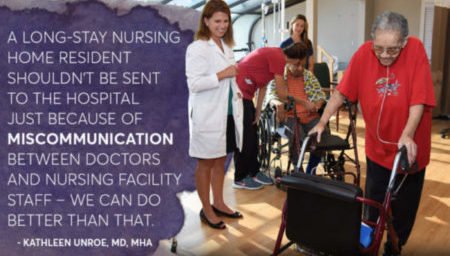Coordination is key to preventing unnecessary hospitalizations
The care of long-term nursing home patients can be fragmented by hospitalizations and re-hospitalizations, which are especially burdensome for frail older adults. There is a significant likelihood of reduced functioning and overall negative impact on their health after discharge from the hospital. Preventing transfers of long-stay nursing home patients to hospitals improves continuity of care and decreases costs to the healthcare system.
Traditionally, clinical diagnosis is used to judge whether the hospital transfer of a nursing home patient is potentially avoidable or unnecessary. However, a recent study from the Regenstrief Institute and Indiana University Center for Aging Research, reports that a patient’s diagnosis is not the best predictor of whether that individual will be transferred to a hospital or remain in place.
“Our data show that preventing avoidable hospitalization is less about clinical diagnosis and more about having coordinated systems in place,” said Kathleen Unroe, M.D., M.H.A. of Regenstrief and IU. “These systems can prevent potentially harmful events that result from unnecessary transfers to the hospital.
“We need to be asking and answering a lot of questions in order to determine if a nursing home patient should be transported to the hospital.”
Dr. Unroe, who led the new study, co-directed Phase I of OPTIMISTIC, short for Optimizing Patient Transfers, Impacting Medical quality and Improving Symptoms: Transforming Institutional Care, and is directing Phase II of OPTIMISTIC. She is the interim director of the Regenstrief and IU Center for Aging Research.
OPTIMISTIC nurses, embedded in 19 nursing homes, reviewed hundreds of transfers to the hospital. The nurses looked at whether patients had one of six diagnoses commonly associated with potentially avoidable hospitalizations: pneumonia, urinary tract infections, dehydration, pressure ulcers, cellulitis, heart failure and chronic obstructive pulmonary disease/asthma. The nurses determined that 25 percent of acute transfers of patients had a diagnosis commonly associated with potentially avoidable hospitalizations versus 22 percent of transfers associated with other diagnoses.
The most common quality improvement opportunities associated with potentially avoidable transfers were a lack of nursing home resources, resources not available at the time of transfer or that the condition might actually have been managed safely with available resources. Improved communications; earlier detection of a change in condition, sign, or symptom; earlier palliative care services and the need for earlier discussion of preferences for care were also reported as opportunities for improvement.
“A long-stay nursing home resident shouldn’t be sent to the hospital just because of miscommunication between doctors and nursing facility staff — we can do better than that,” said Dr. Unroe. “Keeping complex patients in the nursing facility is often the right choice. A nursing facility setting — a familiar place with staff and clinicians who know the patient — may be the patient’s best option in many circumstances. We need to address this issue and improve care. Our findings highlight quality improvement opportunities and strongly reflect the need for multi-targeted solutions like OPTIMISTIC.”
“Investigating the Avoidability of Hospitalizations of Long Stay Nursing Home Residents – Opportunities for Improvement” is published in Innovation in Aging, a peer-reviewed, open access journal of The Gerontological Society of America.
Authors, in addition to Dr. Unroe, are Susan E. Hickman, Ph.D. of the IU School of Nursing; Jennifer L. Carnahan, M.D., M.P.H. and Greg Sachs, M.D. of the Regenstrief Institute and IU School of Medicine and Zach Hass, Ph.D. and Greg Arling, Ph.D. of Purdue University.
This work was supported by the Centers for Medicare and Medicaid Services Funding Opportunity 1E1CMS331488. The opinions expressed in this article do not reflect the view of CMS.









